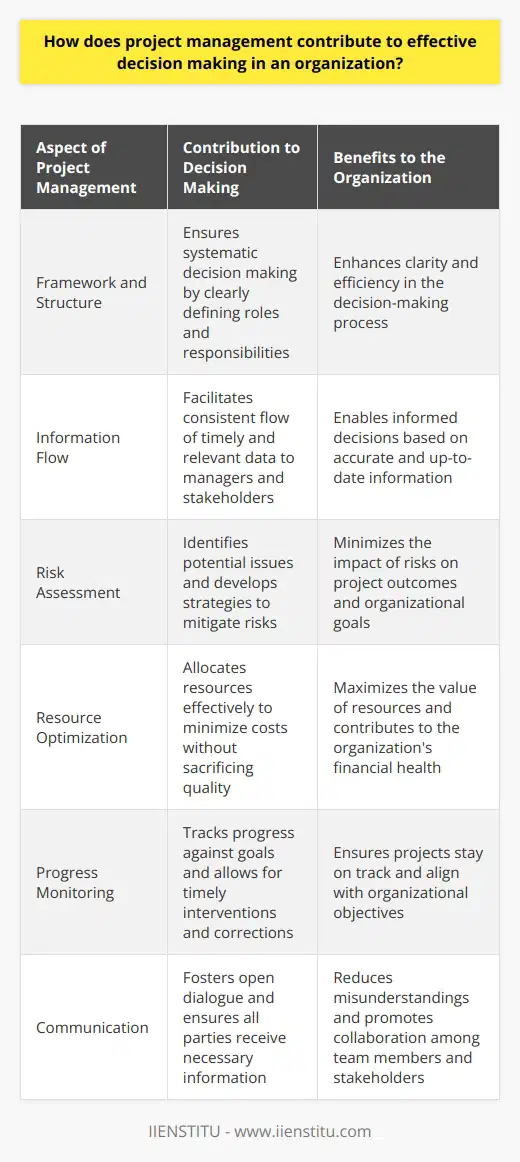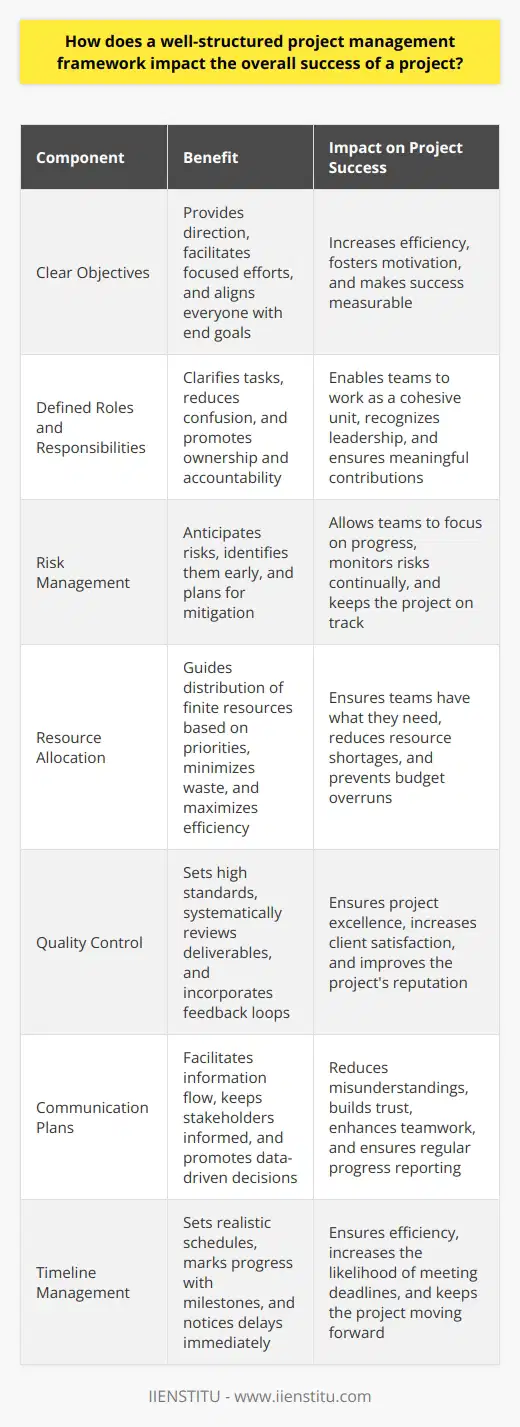
Project Management has increasingly become an intrinsic part of the business landscape; its role cannot be overstated in modern organizations. Essentially, project management underpins the framework within which businesses operate, innovate, and achieve their objectives. It offers a structured yet flexible methodology for navigating complex tasks, ensuring resources are utilized efficiently, and aligning diverse teams towards shared goals.
This blog post delves into various elements of project management, from the fundamental definitions to the more nuanced skills essential for sound decision-making and meticulous planning. In pursuit of this, we will explore the various phases of project management, discuss key skills required in the domain, and examine common challenges and their respective solutions, backed by real-world examples.
The objective is to offer a comprehensive understanding that transcends the theoretical constructs and equips the reader with a pragmatic approach to managing and executing projects effectively.
Definition of Project Management
Project management is a systematic approach to planning, executing, and finalizing projects. It encompasses a set of skills, tools, and techniques applied to project activities to meet or exceed stakeholder expectations, delivering valued outcomes within the constraints of time, cost, and quality. Unlike routine operations, which are repetitive and ongoing, project management focuses on completing specific goals with a definitive timeline, thereby, every project is unique and transient.
Differentiating project management from mundane operational tasks is crucial, as projects typically demand a more adaptive and dynamic approach. Project management necessitates a clear understanding of objectives, a well-defined scope, and a structured yet flexible execution strategy to navigate the peculiar challenges that arise. It enables organizations to break new ground, fostering innovation and driving strategic change.
At the heart of this process lies the Project Manager – a role that requires a multifaceted skill set, including, but not limited to, leadership, negotiation, problem-solving, and conflict management. A competent Project Manager ensures that the project team works synergistically, that decisions are made with clear insight, and that risks are managed effectively. To illustrate, consider the case of a company launching a new product; the Project Manager must expertly coordinate between research and development, marketing, production, and sales teams to ensure a successful launch within the desired time frame and budget.
The Five Phases of Project Management
Initiation
The initiation phase determines the nature and scope of a project. During this stage, the vision of the project is expressed, and the feasibility is assessed. This step is crucial as it sets the groundwork for all subsequent efforts. Consider a tech startup aiming to develop a new software application; this stage would involve market research, identification of customer needs, and preliminary feasibility studies.
A detailed case study of the initiation phase might involve the launch of a new service within an established company. For instance, an airline introducing a premium economy class would first need to evaluate market demand, competitive offerings, and financial implications before proceeding.
Planning
The planning phase is where the project solution is further developed in as much detail as possible and the steps necessary to meet the project's objective are planned. Here, the project's scope is clearly defined and a project management plan is developed. It involves setting goals, defining roles and responsibilities, establishing timelines, and budgeting resources.
An example of effective planning can be seen in the construction industry. For a new infrastructure project, meticulous planning is undertaken to chart out timelines, allocate resources, procure construction materials, and hire subcontractors. Planning must be both rigorous and flexible, to account for any potential delays or changes in scope.
Execution
The execution phase involves turning the project plan into action. This stage typically consumes the most resources and requires meticulous management to ensure that the project remains on course. Tasks are completed, teams are informed, and progress is reported.
In the context of project management, execution might involve the software development life cycle where developers, designers, quality assurance, and other stakeholders come together to build the product. Real-life scenarios often reveal that successful execution relies on proactive communication, efficient problem-solving, and competent leadership.
Monitoring and Control
Monitoring and control procedures take place concurrently with the execution phase. This phase is vital to measure project performance and progression in accordance with the project plan. Adjustments are made as necessary to ensure that the project tracks to its defined objectives.
By way of example, a digital marketing campaign's performance metrics such as reach, engagement, and conversion rates need to be continuously monitored against targets to ensure the campaign's success. This allows marketing managers to refine strategies or adjust the campaign for optimal outcomes.
Closure
In the closure phase, the project is finalized and delivered to the customer. It involves handing over deliverables, releasing project resources, and determining the success of the project. This phase is often neglected but is critical to project success and stakeholder satisfaction.
As an example, consider a project to implement new enterprise resource planning (ERP) software. The closure phase would involve ensuring that all functionalities are operational, employees are trained, and all aspects of the project are documented – ultimately signifying project completion.
Key Skills Required in Project Management
Leadership
Leadership is the cornerstone of effective project management. A project leader must inspire and motivate the team, setting the vision and direction for the project. They must possess the ability to make decisions swiftly, navigate the complexities of team dynamics, and drive the project to successful completion.
The tech sector often showcases successful project leaders who have steered innovative projects through uncharted territories. These leaders are not just managers of tasks but visionaries who foresee obstacles, strategize preemptively, and harness the collective strengths of their teams to forge ahead.
Communication
Without clear and constant communication, the intricacies of a project can become a breeding ground for misunderstandings and errors. It is the project manager's duty to ensure that communication channels are open, transparent, and effective, bridging gaps between diverse stakeholder expectations and the project's deliverables.
For instance, a project involving cross-functional teams across international borders would require a comprehensive communication plan incorporating various languages, cultures, and time zones. The success of global projects often hinges on the effectiveness of these communication strategies.
Risk Management
Risk management allows project managers to identify potential problems before they occur, enabling them to implement solutions to address these risks proactively. Risk assessment and mitigation become a routine part of the project manager's role, demanding foresight and strategic planning.
Case studies highlight how seasoned project managers have saved companies substantial time and money through preemptive risk management. For example, a project manager in the construction industry might anticipate supply chain issues and arrange for backup suppliers well in advance to prevent project delays.
Cost and Time Management
Effective cost and time management skills are integral to successfully delivering projects within the approved budget and deadline. It requires a meticulous approach to estimating, allocating, and controlling resources, ensuring that neither finances nor time are squandered.
Project managers who excel in cost and time management often bring projects to fruition without overruns, like when a product launch aligns with market readiness or a software update rolls out ahead of major industry events, reaping the benefits of impeccable timing.
Challenges in Project Management & Solutions
Project management is a dynamic field that comes with a spectrum of challenges, from scope creep and stakeholder disagreements to resource shortages and technical uncertainties. However, these challenges can be overcome with strategic planning and robust framework implementation.
Equipping teams with the right tools, such as enterprise project management software, can enhance collaboration and tracking. Furthermore, regular training on problem-solving skills training and enrolling in an online certificate course related to project management can keep project managers and their teams at the forefront of industry best practices.
Real-world project management scenarios frequently demonstrate that challenges are part of the journey. For instance, a project team facing budget cuts midway through development needs to reassess priorities and resources, potentially altering the project scope to meet the revised financial constraints.
This blog post has traversed the essential territory of project management, underscoring its significance in modern organizations. From outlining the lifecycle of a project to the indispensable skills required by its managers, we have examined the importance of effective decision-making and meticulous planning.
Reflecting on what has been discussed, it is evident that the field of project management is continually evolving, demanding adaptability and continuous learning. As we conclude, let us emphasis the pivotal role project management plays. Whether through enhancing one's skillset with problem-solving skills training or pursuing an online certificate course in project management, there is a need to constantly refine our approaches and techniques.
We encourage you, the reader, to deploy these insights into your own organizational contexts, to harness the power of project management, making your endeavors not just accomplished but exemplary.
Frequently Asked Questions
How does project management contribute to effective decision making in an organization?
Project Management and Decision Making
Effective decision making stands at the core of successful organizations. Project management significantly contributes to this process. It establishes clear objectives and measurable goals.
Framework Provides Structure
Project management offers a framework. This structure ensures systematic decision making. Teams understand roles and responsibilities.
Information Flow is Streamlined
Data drives informed decisions. Project management facilitates consistent information flow. Managers receive timely, relevant data. Stakeholders are kept in the loop.
Risks are Assessed
Risk assessment is integral. Project managers identify potential issues. Strategies are developed to mitigate risks.
Resources are Optimized
Efficient resource use is crucial. Project management allocates resources effectively. Costs are minimized without sacrificing quality.
Progress is Monitored
Continuous monitoring allows for timely interventions. Project management tracks progress against goals. Deviations are corrected swiftly.
Communication is Central
Clear communication is essential. Project management fosters open dialogue. All parties receive necessary information. Misunderstandings are reduced.
In all, project management plays a pivotal role. It lays the groundwork for effective decision making. Organizations benefit from this structured approach. Employing project management practices enhances outcomes. It leads to strategic, well-informed, and timely decisions.

What are the pivotal project management methodologies that can enhance planning strategies?
Project Management Methodologies Enhance Planning
Planning forms the backbone of successful project management. Multiple methodologies exist to streamline this critical phase. Each brings distinct tools and processes. Effective utilization of these methodologies transforms project planning. It influences outcomes significantly. Let's delve into the pivotal methodologies that can elevate planning.
The Agile Methodology
Agile offers flexibility and adaptability. It thrives in dynamic environments. Projects benefit from iterative work cycles known as sprints. Agile facilitates rapid adjustments. Response to change becomes seamless. Customer feedback integrates continuously, ensuring pertinent result delivery.
- Encourages stakeholder engagement
- Promotes iterative development
- Facilitates change accommodation
The Waterfall Model
Waterfall operates linearly and sequentially. It remains ideal for projects with well-defined outcomes. It follows a rigid structure. Phases do not overlap. Planning gets comprehensive attention. Waterfall ensures thorough upfront analysis.
- Suits predictable, unchanging environments
- Emphasizes thorough documentation
- Supports comprehensive upfront planning
The Lean Approach
Lean focuses on value maximization while minimizing waste. It stems from manufacturing principles. Lean enhances efficiency in planning. It identifies non-value-adding activities. Removing waste streamlines processes. It ensures resource optimization.
- Aims for efficiency and waste reduction
- Increases value delivery
- Optimizes resources effectively
The Six Sigma Strategy
Six Sigma targets defect reduction in current processes. It pairs well with Lean principles. Precision and meticulous planning become paramount. Six Sigma follows DMAIC: Define, Measure, Analyze, Improve, Control. It supports rigorous planning. It enhances quality consistency.
- Drives defect minimization
- Enhances quality assurance
- Integrates with Lean principles
The PRINCE2 Protocol
PRINCE2 (Projects IN Controlled Environments) is process-driven. It provides a structured approach. Phases are clearly defined. Each stage has specific planning guidelines. PRINCE2 implements a framework for consistent project governance.
- Offers a structured procedure
- Defines stages with planning steps
- Instills consistent project governance
The Scrum Framework
Scrum aligns with Agile but focuses on teamwork. It emphasizes roles, events, and artifacts. Sprint planning meetings prioritize tasks. Scrum promotes focus and time-boxed activities. Collaboration enhances planning outcomes. It leads to more effective task prioritization.
- Encourages collaborative work
- Provides clear team roles
- Time-boxes activities for focus
The Critical Path Method
The Critical Path Method (CPM) identifies key activities. These are essential for project completion. CPM lays out the sequence for critical and non-critical tasks. Timing estimates guide planning phases. Resource allocation optimizes based on this path.
- Identifies crucial project activities
- Sequences tasks effectively
- Guides precision timing estimates
The Kanban System
Kanban comes from Japanese manufacturing. It visualizes workflow on boards. Kanban boards improve planning visibility. Task progression becomes transparent. Teams adjust workloads accordingly. It ensures a steady workflow and effective task management.
- Visualizes work processes
- Enhances planning transparency
- Helps manage workloads smoothly
Each methodology offers unique insights. Project managers choose based on project needs. Combining methodologies often yields the best results. Hybrid approaches adapt to project complexities. They ensure robust planning strategies. Understanding these methodologies supports better project outcomes. Implementing them wisely ensures planning success.

How does a well-structured project management framework impact the overall success of a project?
A well-structured project management framework holds the key to project success. It provides a clear roadmap. Teams know what to do. Deadlines become more achievable. The framework also establishes a common language. Stakeholders communicate more effectively. The framework includes key components. Each serves a distinct function. Together, they cover all project aspects.
Clear Objectives
Vision clarity benefits all. Goals set direction. They facilitate focused efforts. Everyone aligns with end goals. Distractions reduce. Efficiency increases. Clear objectives foster motivation. Teams work towards concrete targets. Success becomes measurable. Adjustments are based on solid benchmarks.
Defined Roles and Responsibilities
A framework defines roles well. Team members understand their tasks. Confusion diminishes. Ownership of tasks rises. Responsibilities are clear. Accountability is not diffuse. Teams work as a cohesive unit. Leadership is recognized. Hierarchies serve function, not form. Everyone contributes meaningfully.
Risk Management
Risks come with any project. A framework anticipates risks. It does not react to them. Risks are identified early. Plans are made to mitigate them. Uncertainties become less intimidating. Teams can focus on progress. Risks are monitored continually. Responses are timely. The project stays on track.
Resource Allocation
Resources are finite. A framework guides their allocation. Priorities dictate resource distribution. Waste minimizes. Efficiency maximizes. Teams have what they need. Resource shortages become rare occurrences. Projects run smoother. Budget overruns are less likely.
Quality Control
Quality matters. A framework ingrains quality checks. Standards are set high. Deliverables undergo review systematically. Feedback loops correct issues quickly. Quality control ensures project excellence. Client satisfaction rises. The project's reputation improves. Repeat business becomes a possibility.
Communication Plans
Information is vital. Communication plans facilitate information flow. Stakeholders stay informed. Misunderstandings decrease. Decisions are data-driven. Transparency builds trust. Trust enhances teamwork. Progress is reported regularly. Stakeholders understand the project state.
Timeline Management
Time is non-recoverable. The framework respects this fact. Schedules are realistic. Milestones mark progress. Delays are noticed immediately. Time management ensures efficiency. Deadlines are more often met. The project moves forward without lagging.
Conclusion
A structured framework is indispensable. It guides project endeavors. It turns chaos into order. Frameworks do not guarantee success. But they do improve the odds. They make success possible through structure. They underpin every successful project. A structured approach to the management of a project is crucial, not optional.


